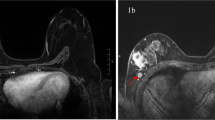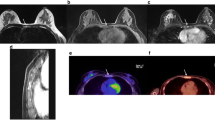Abstract
Purpose
The aim of this study was to describe magnetic resonance imaging (MRI) patterns in 21 patients with histologically proven invasive lobular cancer (ILC) of the breast.
Materials and methods
We retrospectively reviewed MR images of 21 out of 24 women with ILC of the breast. Three women were excluded from the study because they underwent neoadjuvant chemotherapy after MRI. Thirteen of the 24 women had positive clinical findings. All 24 patients underwent mammography, sonography and MRI. MRI was performed to evaluate disease extent and multifocality/multicentricity before modified radical mastectomy (n=5) or quadrantectomy (n=16). Two experienced radiologists reviewed the MRI scans and described the tumour patterns.
Results
We identified five morphological patterns of ILC: a solitary mass with irregular margins (n=8); a mass with smooth margins (n=5); multiple small enhancing foci with interconnecting enhancing strands (n=4); dominant lesion surrounded by small foci (n=3); one MR examination was negative.
Conclusions
Architectural and dynamic features are important in the interpretation of breast MRI findings. ILC may be detected on MRI as solitary or multiple lesions that correspond to tumour morphology on pathologic examination. False-negative MRI findings do occur in a small percentage of ILC.
Riassunto
Obiettivo
Descrivere le caratteristiche RM di 21 pazienti con carcinoma lobulare della mammella (ILC) istologicamente confermato.
Materiali e metodi
Sono state retrospettivamente valutate le immagini RM di 21 su 24 donne portatrici di ILC della mammella. Tre donne sono state escluse dallo studio, in quanto sottoposte a chemioterapia neo-adiuvante dopo l’indagine RM. Tredici donne su 24 presentavano una obiettività clinica. Tutte le 24 pazienti sono state sottoposte a mammografia, ecografia della mammella ed RM. RM è stata effettuata per valutare l’estensione locale di malattia e l’eventuale presenza di multifocalità o multicentricità, prima che le pazienti fossero sotttoposte a mastectomia radicale modificata (n=5) o quadrantectomia (n=16). Due radiologi esperti in diagnostica senologica hanno rivisto le immagini RM e descritto i patterns morfologici delle lesioni tumorali riscontrate.
Risultati
Sono stati riscontrati 5 patterns morfologici di ILC: una formazione espansiva singola a bordi irregolari (n=8); una formazione espansiva singola a bordi netti (n=5); piccoli foci multipli di impregnazione contrastografica interconnessi tra loro (n=4); una formazione espansiva principale circondata da piccoli foci satelliti (n=3); una indagine RM negativa.
Conclusioni
Le caratteristiche morfologiche e dinamiche sono importanti nell’interpretazione della RM mammaria. ILC può essere identificato dalla RM sulla base della presenza di lesioni solitarie o multiple, che corrispondono ai reperti anatomo-patologici. Indagini RM negative sono rare, ma possibili in una bassa percentuale di ILC.
Similar content being viewed by others
References/Bibliografia
Weinstein SP, Orel SG, Heller R et al (2001) MR imaging of the breast in patients with invasive lobular carcinoma. AJR Am J Roentgenol 176:399–406
Sastre-Garau X, Jouve B, Asselain B et al (1996) Infiltrating lobular carcinoma of the breast: clinico-pathologic analysis of 975 cases with reference to data on conservative therapy and metastatic patterns. Cancer 77:113–120
Foote FW Jr, Stewart FW (1941) Lobular carcinoma in situ: a rare form of mammary cancer. Am J Pathol 17:491–496
Rodenko GN, Harms SE, Pruneda JM et al (1996) MR Imaging in the management before surgery of lobular carcinoma of the breast: correlation with pathology. AJR Am J Roentgenol 167:1415–1419
Framarino Dei Malatesta M, Fiorelli C et al (1995) Infiltrating Lobular Carcinoma of the breast (ILC). Eur J Gynaec Oncol 1:36–39
Rosen PP (1991) The pathology of invasive breast carcinoma. In: Harris JR, Henderson IC, Kinne DW (eds) Breast diseases 2nd ed. Lippincot, Philadelphia, pp 272–276
Kreke KN, Gisvold JJ (1993) Invasive lobular carcinoma of the breast: mammographic findings and extent of disease at diagnosis in 184 patients. AJR Am J Roentgenol 161:957–960
Hilleren DJ, Andersson IT, Lindholm K, Linell FS (1991) Invasive lobular carcinoma: mammographic findings in a 10-year experience. Radiology 178:149–154
Le Gal M, Ollivier L, Asselain B et al (1992) Mammographic features of 455 invasive carcinomas. Radiology 185:705–708
Butler RS, Venta LA, Wiley EL et al (1999) Sonographic evaluation of infiltrating lobular carcinoma. AJR Am J Roentgenol 172:325–330
Sickles EA (1991) The subtle and atypical mammographic features of invasive lobular carcinoma. Radiology 178:25–26
Watson L (2001) Breast cancer: diagnosis, treatment and prognosis. Radiol Technol 73:45–61
Paramugal CP, Helvie MA, Adler DD (1995) Invasive lobular carcinoma: sonographic appearance and role of sonography in improving diagnostic sensitivity. Radiology 195:231–234
Lesser ML, Rosen PP, Kinne DW (1982) Multicentricity and bilaterality in invasive carcinoma. Surgery 91:234–240
Dixon JM, Anderson TJ, Page DL et al (1983) Infiltrating lobular carcinoma of the breast: an evaluation of the incidence and consequence of bilateral disease. Br J Surg 70:513–516
Boetes C, Mus RDM, Holland R et al (1995) Breast tumors: comparative accuracy of MR imaging relative to mammography and US for demonstrating extent. Radiology 197:743–747
Qayyum A, Birdwell RL, Daniel BL et al (2002) MR imaging features of infiltrating lobular carcinoma of the breast: histopathologic correlation. AJR Am J Roentgenol 178:1227–1232
Kaiser WA, Zeitler E (1989) MR imaging of breast: fast imaging sequences with and without Gd-DTPA. Preliminary observations. Radiology 170:681–686
Harms SE, Flamig DP, Hesley KL et al (1993) MR imaging of the breast with rotating delivery of excitation off resonance: clinical experience with pathologic correlation. Radiology 187:493–501
Boetes C, Barentsz JO, Mus RD et al (1994) MR characterization of suspicious breast lesions with a gadolinium-enhanced TurboFLASH subtraction technique. Radiology 193:777–781
Heywang-Kobrunner SH, Viehweg P, Heinig A, Kuchler C (1997) Contrastenhanced MRI of the breast: accuracy, value, controversies, solutions. Eur J Radiol 24:94–108
Sherif H, Mahfouz AE, Oellinger H et al (1997) Peripheral washout sign on contrast enhancement MR images of the breast. Radiology 205:209–213
Kuhl CK, Mielcarek P, Klaschik S et al (1999) Dynamic breast MR imaging: are signal intensity time course data useful for differential diagnosis of enhancing lesions? Radiology 211:101–110
Kim SJ, Morris EA, Liberman L et al (2001) Observer variability and application of BI-RADS terminology for breast MR Imaging. AJR Am J Roentgenol 177:551–557
American College of Radiology (ACR) (1998) Illustrated breast imaging reporting and data system (BI-RADS), 3rd edn. American College of Radiology, Reston, VA
Lehman CD, Peacock S, DeMartini WB, Chen X (2006) A new automated software system to evaluate breast MR examinations: improved specificity without decreased sensitivity. AJR Am J Roentgenol 187:51–56
Gisvold JJ (1990) Imaging of the breast: techniques and results. Mayo Clin Proc 65:56–66
Mendelson EB, Harris KM, Doshu N, Tobon H (1989) Infiltrating lobular carcinoma: mammographic patterns with pathologic correlation. AJR Am J Roentgenol 153:265–271
Yeh C, Titus JM, Kalisher L (1997) Breast imaging case of the day. Infiltrating lobular carcinoma. Radiographics 17:1328–1332
Cornford EJ, Wilson ARM, Athanassiou E et al (1995) Mammographic features of invasive lobular and invasive ductal carcinoma of the breast: a comparative analysis. Br J Radiol 68:450–453
Holland R, Hendriks JH, Mravunac M (1983) Mammographically occult breast cancer. Cancer 52:1810–1819
Dornkers DS (1985) Mammographisch occult mammacarcinoom. Ned Tijdschr Geneesk 129:1632–1635
Martin JE, Moskowitz M, Milbrath JR (1979) Breast cancer missed by mammography. AJR Am J Roentgenol 132:737–739
Beute BJ, Kalisher L, Hutter RV (1991). Lobular carcinoma in situ of the breast: clinical, pathologic, and mammographic features. AJR Am J Roentgenol 157:257–265
Skaane P, Skjorten F (1999) Ultrasonographic evaluation of invasive lobular carcinoma. ACTA Radiol 40:369–375
Evans N, Lyons K (2000) The use of ultrasound in the diagnosis of invasive lobular carcinoma of the breast less than 10 mm in size. Clin Radiol 55:261–263
Chintana PP, Helvie MA, Adler DD (1995) Invasive lobular carcinoma: sonographic appearance and role of sonography in improving diagnostic sensitivity. Radiology 195:231–234
Nokes SR, Pierce W, Abraham DC, Harms SE (1999) Radiology, infiltrating lobular carcinoma. J Ark Med Soc 96:176–177
Harms SE (1998) Integration of breast magnetic resonance imaging with breast cancer treatment. Top Magn Reson Imaging 9:79–91
Schelfout K, Van Goethem M, Kersschot E et al (2004) Preoperative breast MRI in patients with invasive lobular breast cancer. Eur Radiol 14:1209–1216
Levrini G, Nicol F, Borasi G et al (2006) MRI patterns of invasive lobular breast cancer. Eur J Radiol 59:472
Mumtaz H, Hall-Craggs MA, Davidson T et al (1997) Staging of symptomatic primary breast cancer with MR imaging. AJR Am J Roentgenol 169:417–424
Orel SG, Schnall MD, Powell CM et al (1995) Staging of suspected breast cancer: effect of MR imaging and MR-guided biopsy. Radiology 196:115–122
Cooney BS, Orel SG, Schnall MD, Troupin RH (1994) Invasive lobular carcinoma in a patient with synchronous ductal carcinoma in situ: detection with MR imaging. AJR Am J Roentgenol 162:1318–1320
Esserman L, Hylton N, Yassa L et al (1999) Utility of magnetic resonance imaging in the management of breast cancer: evidence for improved preoperative staging. J Clin Oncol 17:110–119
Fischer U, Kopka L, Grabbe E (1999) Breast carcinoma: effect of preoperative contrast-enhanced MR imaging on the therapeutic approach. Radiology 213:881–888
Davis PL, McCarty KS Jr (1998) Magnetic resonance imaging in breast cancer staging. Top Magn Reson Imaging 9:60–75
Orel SG, Weinstein SP, Schnall MD (1999) Breast MR imaging in patients with axillary node metastases and unknown primary malignancy. Radiology 212:543–549
Wilhem K, Grebe P, Teifke A et al (1992) Das Lobulare Mammakarzinom in der Kerspintomographie. Akt Radiol 2:373
Perry N, Broeders M, de Wolf C, Tornberg S, Schouten J (eds) (1996) European Guidelines for Quality Assurance in Mammography Screening. 2nd edn. European Commission, Brussels
Orel SG, Schnall MD, LiVolsi VA, Troupin RH (1994) Suspicious breast lesions: MR imaging with radiologicpathologic correlation. Radiology 190:485–493
Stelling CB, Powell DE, Mattingly SS (1987) Fibroadenomas: histopathologic and MR imaging features. Radiology 162:399–407
Heywang SH, Bassermann R, Fenzl G et al (1987) MRI of the breast: histopathologic correlation. Eur J Radiol 7:175–182
Kuhl CK, Klaschik S, Mielcarek P et al (1999) Do T2-weighted pulse sequences help with the differential diagnosis of enhancing lesions in dynamic breast MRI? J Magn Reson Imaging 9:187–196
Author information
Authors and Affiliations
Corresponding author
Rights and permissions
About this article
Cite this article
Levrini, G., Mori, C.A., Vacondio, R. et al. MRI patterns of invasive lobular cancer: T1 and T2 features. Radiol med 113, 1110–1125 (2008). https://doi.org/10.1007/s11547-008-0308-z
Received:
Accepted:
Published:
Issue Date:
DOI: https://doi.org/10.1007/s11547-008-0308-z




